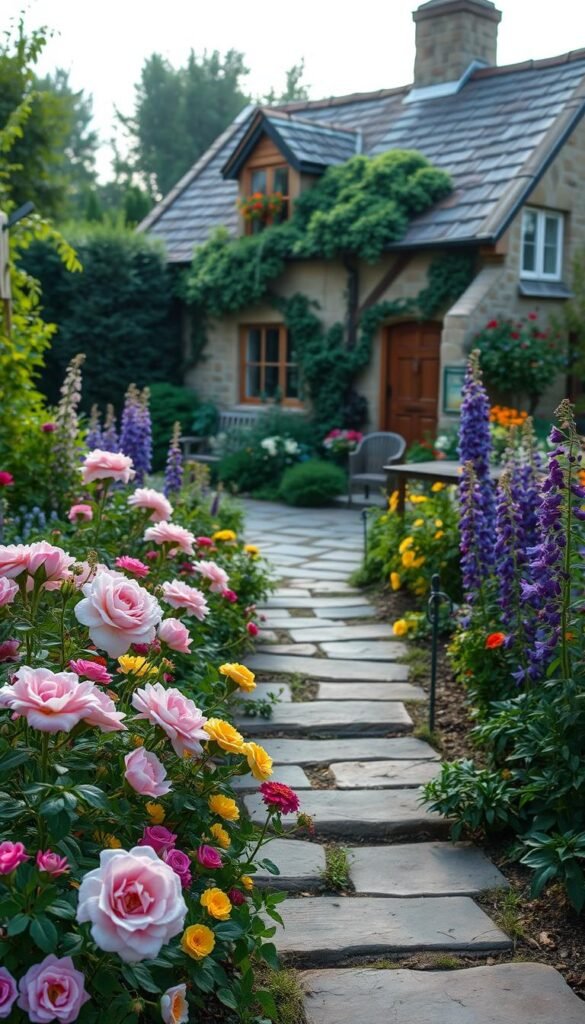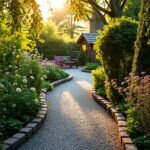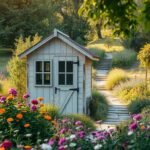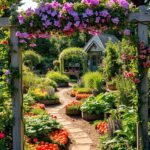Imagine stepping into an outdoor space bursting with life, where flowers spill over pathways and every corner feels delightfully unexpected. This is the magic of informal gardening styles rooted in centuries-old traditions. Originally developed in England over a thousand years ago, these spaces prioritize natural beauty over rigid structure, inviting you to embrace creativity rather than perfection.
At their core, these landscapes celebrate abundance. Think roses climbing weathered fences, lavender mingling with vegetables, and herbs adding fragrance to vibrant flower beds. Unlike formal arrangements, they blend practicality with charm—a philosophy that lets you mix edible plants with ornamental blooms for a truly personalized touch. Stone accents, rustic birdbaths, and winding paths complete the look, creating focal points that feel both timeless and inviting.
What makes this approach so appealing? It’s the freedom to experiment. There’s no need for precise symmetry or meticulously trimmed hedges. Instead, you’ll discover how elevating your space with relaxed textures and layered plantings can transform even small yards into whimsical retreats. Whether you’re a seasoned gardener or just starting out, this style adapts to your vision while staying budget-friendly.
Ready to explore how “organized chaos” can work for you? This guide walks through everything from selecting hardy perennials to incorporating vintage decor. You’ll learn why imperfection is part of the charm and how to craft a space that feels uniquely yours—one daisy, foxglove, and sweet pea at a time.
Embracing the Cottage Garden Aesthetic
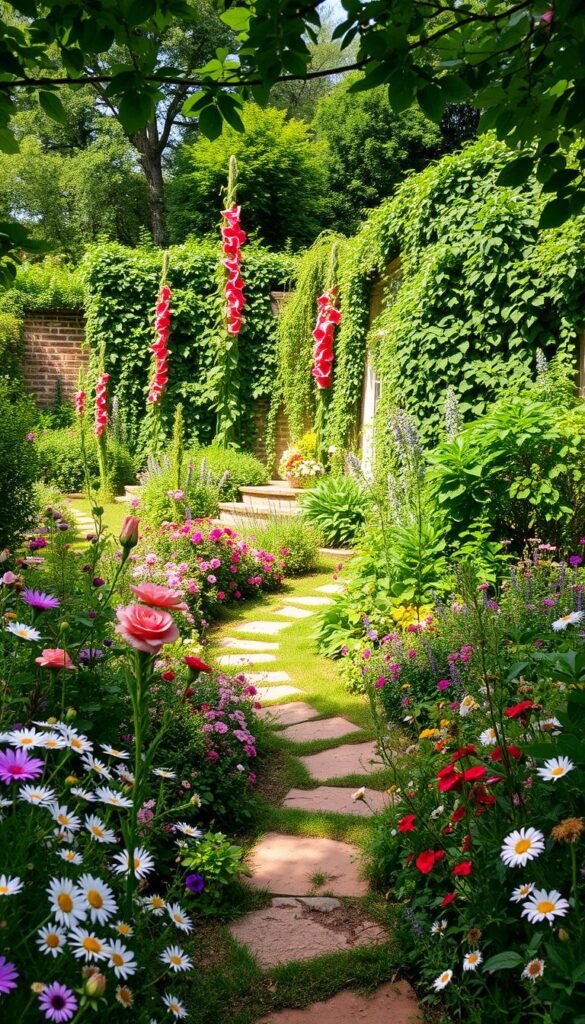
Think of a space where nature’s spontaneity blends with rustic charm effortlessly. This approach thrives on joyful imperfection, letting plants mingle freely while supporting local ecosystems. Unlike manicured landscapes, it feels alive—a living canvas that changes daily.
The Charm of Informal, Whimsical Design
Forget rigid rows or measured spacing. Here, flowers tumble over stone edges, and slightly wild growth becomes part of the appeal. This design philosophy welcomes self-seeding blooms and uneven heights, creating habitats for pollinators like hummingbirds and bees.
Why does this work so well? It mirrors nature’s patterns. Clusters of lavender might frame a weathered bench, while climbing roses soften fences. The result feels inviting, not staged—a place where beauty unfolds naturally.
Mixing Flowers, Shrubs, and Hardscape for a Natural Look
Combine feathery grasses with bold peonies, or let flowering shrubs peek through iron arches. Add gravel paths or reclaimed bricks to ground the cottage garden style. These elements guide exploration without dominating the scene.
Over time, your space evolves. Annuals reseed in new spots, perennials expand their territory, and vines climb higher. This ever-changing look keeps things fresh, reflecting the cottagecore aesthetic’s love for organic storytelling. Your garden becomes a personal retreat where every season writes its own chapter.
Cottage Garden Design Layout Ideas: Planning a Charming, Rambler-Style Garden
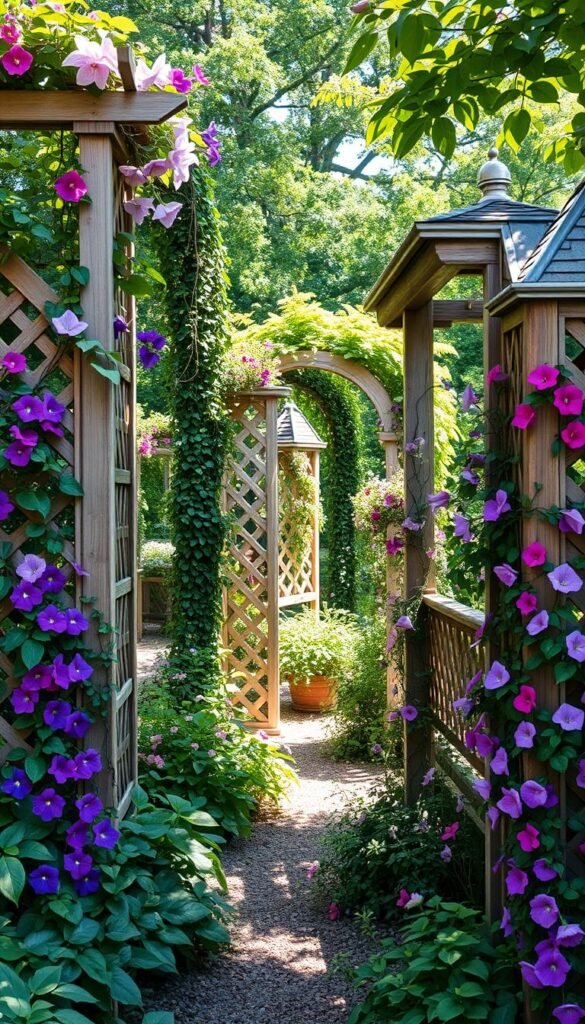
Your outdoor sanctuary begins with a vision that reflects your unique taste and the character of your home. Start by sketching ideas or using free tools like Plan-a-Garden to map out your space. These resources help you experiment with plant groupings, pathways, and structural accents before digging your first hole.
Defining Your Garden’s Personality and Style
Ask yourself: Should your space feel cozy or expansive? Playful or serene? Match plant choices to your home’s architecture—think daisies and lavender for farmhouse vibes, or hydrangeas near colonial-style homes. As one landscape designer notes:
“A garden should feel like a handwritten letter, not a printed template.”
Organize plants into three layers for balance:
| Height | Examples | Purpose |
|---|---|---|
| Low-growing | Thyme, sedum | Edge pathways |
| Medium | Peonies, salvias | Mid-border color |
| Foundational | Boxwood, spirea | Year-round structure |
Incorporating Rambler Elements for Vertical Interest
Train climbing roses up weathered trellises or let clematis scramble over arches. These vertical accents draw the eye upward while saving ground space. Add creative gardening ideas like repurposed ladders as plant supports for whimsical charm.
Break up dense plantings with flagstone stepping stones or clustered rocks. These natural pauses let visitors appreciate your handiwork without feeling overwhelmed by abundance.
Planning Your Cottage Garden: Getting Started

Creating a thriving outdoor retreat begins with smart groundwork rather than grand gestures. Focus on manageable steps to avoid burnout while nurturing your green thumb. Let’s explore how to set up a resilient foundation that grows alongside your skills.
Choosing the Right Space and Soil Preparation
Begin with a sunny area that drains well—most flowering plants crave 6+ hours of sunlight. Test your soil using affordable kits from garden centers. Results reveal pH levels and nutrient gaps, guiding amendments like compost or lime.
Enrich planting beds with organic matter such as aged manure or worm castings. This boosts fertility and texture, creating a welcoming home for roots. For low-effort soil improvement, layer cardboard under compost to suppress weeds naturally.
| Mulch Type | Benefits | Best For |
|---|---|---|
| Bark chips | Long-lasting weed control | Pathways |
| Leaf mold | Fast decomposition | Vegetable beds |
| Grass clippings | Nitrogen boost | Flower borders |
Apply 2-3 inches of mulch annually to lock in moisture and deter weeds. Start with one or two beds, expanding yearly as you learn your space’s microclimates. This gradual approach lets you adapt to what thrives in your unique ground conditions.
Selecting and Combining Cottage Garden Flowers
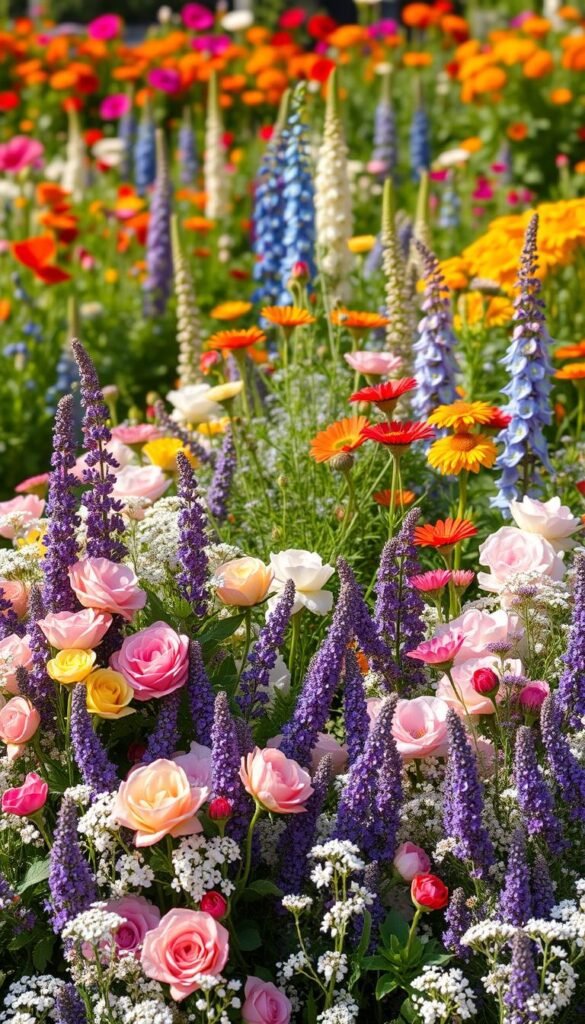
Picture a tapestry of blooms that shifts with the sun’s rhythm. Your plant choices become the brushstrokes painting this living masterpiece—bold dahlias in summer, delicate snowdrops in winter, and everything in between. Let’s explore how to curate flowers that dance through the seasons while maintaining that effortless charm.
Must-Have Flowers for Every Season
Start with perennials like peonies and lavender for reliable structure. Pair them with spring bulbs like tulips and late-blooming asters to keep color flowing year-round. This mix ensures something always catches the eye, whether it’s June roses or October chrysanthemums.
| Season | Flower Examples | Key Features |
|---|---|---|
| Spring | Tulips, foxgloves | Early color, vertical accents |
| Summer | Roses, phlox | Fragrance, pollinator magnets |
| Fall | Asters, sedum | Late blooms, texture |
Blending Plant Types for Dynamic Displays
Combine quick-growing annuals like zinnias with enduring perennials like delphiniums. Allow self-seeding varieties like columbine to pop up unexpectedly—these happy surprises create that coveted “organized chaos” look. Repeat key plants in clusters across beds to unify your space naturally.
Tall hollyhocks framing a gate? Yes. Low-growing thyme softening a path? Perfect. Layering heights and textures adds depth while giving butterflies landing pads. Remember: Your cottage garden flowers should tell a story that changes with each chapter of the year.
Essential Tips for Successful Cottage Garden Planting
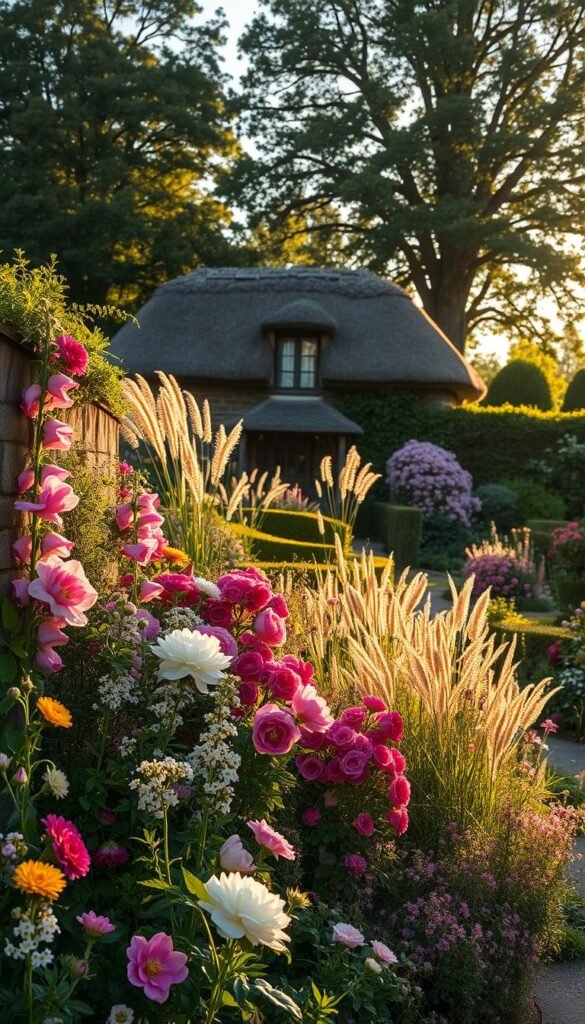
Transform your outdoor space into a living masterpiece by working with nature rather than against it. Strategic layering and thoughtful placement turn random blooms into a cohesive story. Let’s break down the process into manageable steps that build both structure and charm.
Step-by-Step Planting Techniques
Begin by sorting your plants into three tiers. Low-growing varieties like creeping thyme create living ground cover, while medium-height salvias add mid-level drama. Tall shrubs like hydrangeas form the backbone of your design.
| Layer | Role | Examples |
|---|---|---|
| Foundation | Vertical anchors | Roses, lilacs |
| Border | Color transitions | Catmint, coreopsis |
| Ground | Texture & weed control | Sedum, ajuga |
Establish perennials first, spacing them 18-24 inches apart. Tuck bulbs like daffodils between them for spring surprises. Fill gaps with annuals like cosmos—their airy stems blend beautifully with established plants.
“Limit your palette to three main hues for harmony,” suggests master gardener Laura Baird. “Let one color dominate, another accent, and the third provide contrast.” Cluster ruby-red poppies near pink phlox, or pair purple sage with white Shasta daisies.
Use ground cover strategically between stepping stones or along border edges. These living carpets suppress weeds while softening hard edges. For front-of-bed interest, try silvery lamb’s ear—its velvety leaves sparkle in morning light.
Plant in triangular groups of five or seven for natural-looking drifts. Allow foliage to gently overlap, creating that lush, interconnected look. Remember: Your garden grows into itself over time, so leave room for tomorrow’s surprises.
Incorporating Hardscape Elements and Decorative Accents
Your outdoor retreat gains character when natural elements meet crafted details. Hardscaping blends function with beauty, guiding movement while adding visual interest. Start with durable materials like flagstone or reclaimed wood—they age gracefully and complement loose planting styles.
Designing Curved Pathways with Flagstone and Mulch
Meandering paths invite exploration. Lay irregular flagstone pieces with gaps for creeping thyme or moss. Fill spaces with mulch to suppress weeds and soften edges. This approach creates organic flow, letting visitors pause at clusters of blooms or whimsical focal points.
Using Trellises, Arbors, and Vintage Touches
Vertical structures maximize space and charm. Train sweet peas up DIY trellises made from salvaged materials. Add an arbor draped in climbing roses as a gateway between garden “rooms”. Scatter weathered lanterns or iron accents for nostalgic flair.
Introduce finishing touches gradually—a birdbath here, a stone bench there. These elements anchor your space without overwhelming it. Remember: the goal is balance, where every addition feels discovered, not placed.

